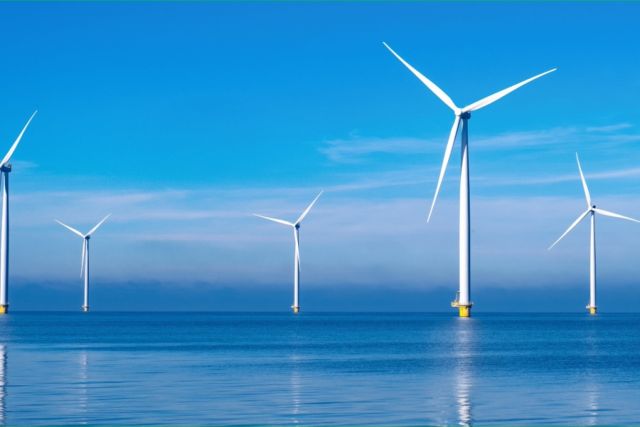
The U.S. Interior Department’s schedule includes up to a dozen lease sales through 2028 for offshore wind, compared to three for oil and gas lease sales through 2029. (Source: Shutterstock.com)
Offshore wind energy players will have opportunities to bid for development rights in up to a dozen lease sales through 2028, including four this year, after the U.S. Interior Department unveiled on April 24 its latest five-year plan.
The offshore wind leasing schedule, tied to federal oil and gas leasing as stipulated by the Inflation Reduction Act (IRA), includes sales across the Atlantic, Gulf of Mexico (GoM), Pacific and offshore U.S. territories. Its release comes as the Biden administration continues efforts to boost offshore wind capacity. So far, eight commercial-scale offshore wind projects have been approved and four offshore wind lease auctions have been held under the current administration.
“As we look toward the future, this new leasing schedule will support the types of renewable energy projects needed to lower consumer costs, combat climate change, create jobs to support families and ensure economic opportunities are accessible to all communities,” Interior Secretary Deb Haaland said in release. “Our offshore wind leasing schedule will provide predictability to help developers and communities plan ahead and will provide the confidence needed to continue building on the tremendous offshore wind supply chain and manufacturing investments that we’ve already seen.”
The U.S. is targeting 30 gigawatts (GW) of offshore wind energy capacity. To date, more than 10 GW—enough to power nearly 4 million homes according to the Interior Department—of clean energy projects have been approved.
However, offshore wind developers have endured challenges related to high interest rates, supply chain issues and inflation. The woes have slowed some projects and halted others, but some have continued to move forward as regulators—including at the state and federal levels—do what they can to ease burdens.
The Interior Department on April 24 also said it finalized a rule to increase certainty and reduce offshore wind project costs by modernizing regulations and streamlining processes. Besides establishing a public renewable energy leasing schedule, the rule improves the facility design, fabrication and installation certification and verification process; tailors financial assurance requirements and instruments; and reforms the Bureau of Ocean Energy Management’s (BOEM) renewable energy auction regulations among other changes, according to a news release.
While the new wind leasing schedule is seen as a positive, consistent and predictable lease sales are needed for all offshore energy production including oil and gas, according to Erik Milito, president of the National Ocean Industries Association. In an April 24 statement, Milito said the Interior Department may struggle to comply with the IRA and have annual offshore wind lease sales, given only three oil and gas lease sales are scheduled for the next five years.
RELATED
It’s Final: Only 3 Oil, Gas Lease Sales Set for GoM in New Program
“Any actions to delay or reduce Gulf of Mexico oil and gas lease sales could inadvertently delay offshore wind lease sales,” Milito said. “Periods of inactivity in lease sales—whether for wind or oil and gas—only increase uncertainty and risk driving investment dollars overseas. Sustaining regular lease sales for all energy sources ensures energy continuity, promotes economic growth and maintains America’s competitiveness in the global energy market.”
The IRA states that BOEM can only issue a lease for offshore wind development if, in the previous year, the agency offered at least 60 million acres for oil and gas leasing on the Outer Continental Shelf.
The latest offshore wind lease schedule includes four sales for 2024: one each in the Central Atlantic, Gulf of Maine, GoM and offshore Oregon. The schedule has one sale planned for 2025 in the GoM; one in 2026 for the Central Atlantic; and two for 2027 in the GoM and New York Bight. Four more are scheduled in 2029: offshore California, a U.S. territory, the Gulf of Maine and offshore Hawaii.
Recommended Reading
Artificial Lift Firm Flowco’s Stock Surges 23% in First-Day Trading
2025-01-22 - Shares for artificial lift specialist Flowco Holdings spiked 23% in their first day of trading. Flowco CEO Joe Bob Edwards told Hart Energy that the durability of artificial lift and production optimization stands out in the OFS space.
Not Sweating DeepSeek: Exxon, Chevron Plow Ahead on Data Center Power
2025-02-02 - The launch of the energy-efficient DeepSeek chatbot roiled tech and power markets in late January. But supermajors Exxon Mobil and Chevron continue to field intense demand for data-center power supply, driven by AI technology customers.
Chevron Technology Ventures Would Like to See the Manager
2025-03-13 - Chevron Corp.’s Chevron Technology Ventures, which turns 25 this year, pays close attention to leadership teams when making investment decisions in technology startups.
BlackRock CEO: US Headed for More Inflation in Short Term
2025-03-11 - AI is likely to cause a period of deflation, Larry Fink, founder and CEO of the investment giant BlackRock, said at CERAWeek.
The Private Equity Puzzle: Rebuilding Portfolios After M&A Craze
2025-01-28 - In the Haynesville, Delaware and Utica, Post Oak Energy Capital is supporting companies determined to make a profitable footprint.
Comments
Add new comment
This conversation is moderated according to Hart Energy community rules. Please read the rules before joining the discussion. If you’re experiencing any technical problems, please contact our customer care team.






